
Spitting spiders (Scytodidae) is a family of araneomorph spiders first described by John Blackwall in 1864. It contains over 250 species in five genera, of which Scytodes is the best-known.
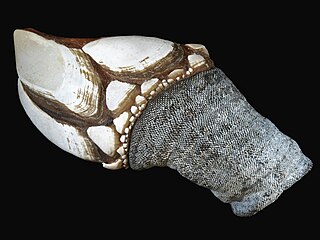
Goose barnacles, also called stalked barnacles or gooseneck barnacles, are filter-feeding crustaceans that live attached to hard surfaces of rocks and flotsam in the ocean intertidal zone. Goose barnacles formerly made up the taxonomic order Pedunculata, but the group has been found to be polyphyletic, with its members scattered across multiple orders of the infraclass Thoracica.

Thoracica is an infraclass of crustaceans which contains the most familiar species of barnacles found on rocky coasts, such as Semibalanus balanoides and Chthamalus stellatus. They have six well-developed limbs, and may be either stalked or sessile. The carapace is heavily calcified. The group includes free-living and commensal species.

Scytodes thoracica is a spitting spider, so called because it spits a venomous sticky silken substance over its prey. Its size ranges between 3–6 mm (0.12–0.24 in). The carapace is unusual in sloping upwards towards its rear end, whereas the abdomen slopes downwards.

Tree wētā are wētā in the genus Hemideina of the family Anostostomatidae. The genus is endemic to New Zealand. There are seven species within the genus Hemideina, found throughout the country except lowland Otago and Southland. Because many tree wētā species are common and widespread they have been used extensively in studies of ecology and evolution.

The spotted bush warbler is a species of Old World warbler in the family Locustellidae. It is found in the northern Himalayas, Yunnan and central China, in the countries of Bangladesh, Bhutan, China, India, Myanmar and Nepal. Its natural habitat is arboreal forests.
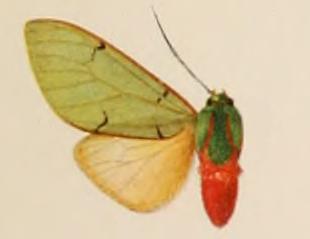
Chlorhoda is a genus of moths in the subfamily Arctiinae erected by George Hampson in 1901.

Laphria is a genus described by Johann Wilhelm Meigen in 1803, belonging to the family Asilidae, subfamily Laphriinae. Members of this genus are known as bee-like robber flies. This genus has a Holarctic distribution, occurring in Europe, Asia, and North America. They prey on a variety of insects, including other robber flies, bees, wasps and beetles. Like other asilids, they use their proboscis to penetrate the body of their prey and inject enzymes which dissolve the tissues.

Harpocera thoracica is a species of bugs from Miridae family.

Belippa is a genus of moths in the family Limacodidae erected by Francis Walker in 1865.

Viridistria thoracica is a moth of the family Noctuidae first described by Frederic Moore in 1882. It is found in northern India.

The Chthamaloidea are a subdivision of Balanomorpha proposed by Newman and Ross to include barnacles with shell wall composed of rostrum, carina, and one to three pairs of latera, rarely supplemented with one or more whorls of basal imbricating plates. The rostrolatus enters the sheath, but rarely fuses with the rostrum, as in the three higher superfamilies. Shell plates are simple in construction, solid, and incorporate organic chitin between carbonate layers. Opercular plates are deeply interlocked, and in some genera, may become concrescent with age. Soft part morphology includes concave labrum without notch in the central part. Cirrus III more resembles Cirrus IV than II, or may be intermediate in structure. Caudal appendages present in some species.

Anthia thoracica, the two-spotted ground beetle, is a species of beetles of the family Carabidae.

Enoplognatha thoracica is a spider species with Holarctic distribution. It is notably found in Lithuania.
Adoxophyes thoracica is a species of moth of the family Tortricidae. It is found in New Guinea.

The Taiwan bamboo partridge is a species of bird in the family Phasianidae. It is endemic to Taiwan. It was formerly considered a subspecies of the Chinese bamboo partridge.
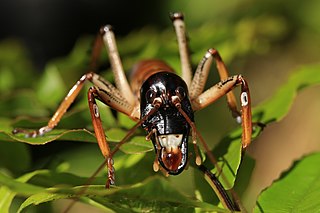
Hemideina thoracica, commonly known as the Auckland tree wētā or tokoriro is a cricket-like insect. It is endemic to New Zealand and is found over most of the North Island, except for the Wellington region and regions 900 metres above sea level. This species is an arboreal, herbivorous generalist however, it is also thought to be polyphagous and is found in all wooded habitats, including forest, scrub and suburban gardens.
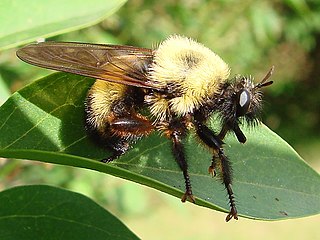
Laphria thoracica is a species of robber flies in the family Asilidae.
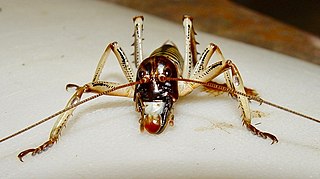
Hemideina trewicki, the Hawkes Bay tree wētā, is a large arboreal long-horned cricket in the order Orthoptera. The species is endemic to New Zealand and restricted to the Hawke's Bay region of North Island
Sepsis thoracica, more commonly known as the black scavenger fly, a species of fly from the genus Sepsis and the family Sepsidae. It was discovered by Robineau-Desvoidy in 1830. It resembles a small flying ant. The fly is most commonly found inhabiting cow dung.

















